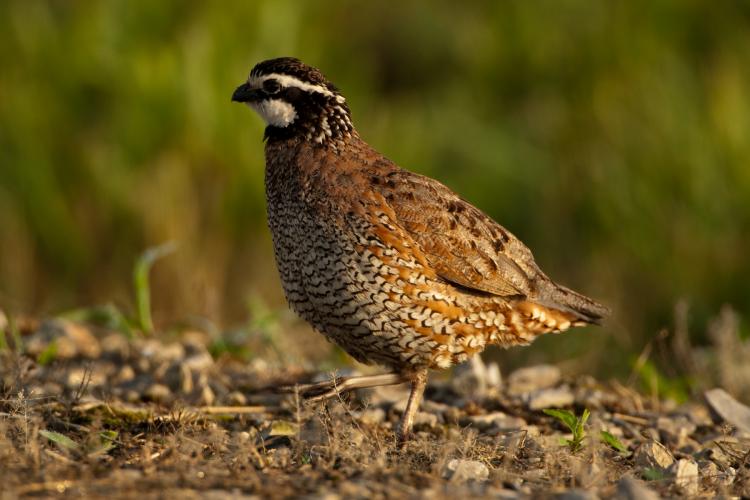Bobwhite is a popular fellow. In spring and summer across fields, fencerows and croplands, Bob whistles his name. He sounds cheerful, but Bobwhite’s life is often short and filled with hardship.
This Bob is not a person but a bird: the bobwhite quail.
During spring and summer, Bob is a devoted family man. A male pairs with one female and helps incubate the dozen or more eggs she lays. Quail build well-concealed nests on the ground in weedy fields, fencerows and pastures. Young bobwhite quail are born feathered and ready to forage. They leave the nest almost immediately to look for food with one or both parents. Because their rapid growth requires a lot of protein, young quail eat mostly insects and spiders during the summer months.
During fall and winter, quail form tightly-knit groups called “coveys”. Coveys usually contain 10-12 birds, and they offer the birds advantages against predators and cold weather. During winter, they feed on grain and weed seeds.
While many predator species will prey on quail, no predators specialize on quail exclusively. Despite predation, the bobwhite quails’ fate is largely determined by factors like severe winter weather, and the availability of food and escape cover. Fortunately, Bob is resilient. Given a good habitat, enough bobwhite quail will survive to whistle their name come spring.
Bobwhite Delight
- The northern bobwhite is a popular game bird and is welcomed by farmers as a destroyer of weeds and harmful insects. For people who don’t hunt, these native quail are beloved for their clear, loud song and exciting eruption when flushed.
- The “bob-WHITE!” call is distinctive, but it is mimicked by a number of other bird species.
- They’re camouflaged for a reason: Many species prey upon bobwhites, including mammals such as foxes, coyotes and raccoons, as well as hawks, owls, snakes and other species.
- Bobwhite populations have been declining in recent decades, due primarily to habitat loss and unfavorable weather during winter and nesting season. The Missouri Department Conservation is helping to reverse the downward trend in bobwhite numbers and improve the statewide population through several initiatives including public education, recreation opportunities and landowner assistance.
Learn more about the bobwhite quail in the MDC Field Guide.




Recent Posts
























